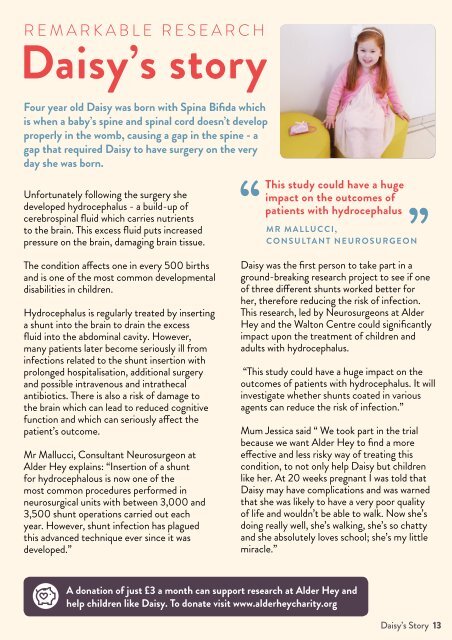INSPIRED #6
Create successful ePaper yourself
Turn your PDF publications into a flip-book with our unique Google optimized e-Paper software.
REMARKABLE RESEARCH<br />
Daisy’s story<br />
Four year old Daisy was born with Spina Bifida which<br />
is when a baby’s spine and spinal cord doesn’t develop<br />
properly in the womb, causing a gap in the spine - a<br />
gap that required Daisy to have surgery on the very<br />
day she was born.<br />
Unfortunately following the surgery she<br />
developed hydrocephalus - a build-up of<br />
cerebrospinal fluid which carries nutrients<br />
to the brain. This excess fluid puts increased<br />
pressure on the brain, damaging brain tissue.<br />
This study could have a huge<br />
impact on the outcomes of<br />
patients with hydrocephalus<br />
MR MALLUCCI,<br />
CONSULTANT NEUROSURGEON<br />
The condition affects one in every 500 births<br />
and is one of the most common developmental<br />
disabilities in children.<br />
Hydrocephalus is regularly treated by inserting<br />
a shunt into the brain to drain the excess<br />
fluid into the abdominal cavity. However,<br />
many patients later become seriously ill from<br />
infections related to the shunt insertion with<br />
prolonged hospitalisation, additional surgery<br />
and possible intravenous and intrathecal<br />
antibiotics. There is also a risk of damage to<br />
the brain which can lead to reduced cognitive<br />
function and which can seriously affect the<br />
patient’s outcome.<br />
Mr Mallucci, Consultant Neurosurgeon at<br />
Alder Hey explains: “Insertion of a shunt<br />
for hydrocephalous is now one of the<br />
most common procedures performed in<br />
neurosurgical units with between 3,000 and<br />
3,500 shunt operations carried out each<br />
year. However, shunt infection has plagued<br />
this advanced technique ever since it was<br />
developed.”<br />
Daisy was the first person to take part in a<br />
ground-breaking research project to see if one<br />
of three different shunts worked better for<br />
her, therefore reducing the risk of infection.<br />
This research, led by Neurosurgeons at Alder<br />
Hey and the Walton Centre could significantly<br />
impact upon the treatment of children and<br />
adults with hydrocephalus.<br />
“This study could have a huge impact on the<br />
outcomes of patients with hydrocephalus. It will<br />
investigate whether shunts coated in various<br />
agents can reduce the risk of infection.”<br />
Mum Jessica said “ We took part in the trial<br />
because we want Alder Hey to find a more<br />
effective and less risky way of treating this<br />
condition, to not only help Daisy but children<br />
like her. At 20 weeks pregnant I was told that<br />
Daisy may have complications and was warned<br />
that she was likely to have a very poor quality<br />
of life and wouldn’t be able to walk. Now she’s<br />
doing really well, she’s walking, she’s so chatty<br />
and she absolutely loves school; she’s my little<br />
miracle.”<br />
A donation of just £3 a month can support research at Alder Hey and<br />
help children like Daisy. To donate visit www.alderheycharity.org<br />
Daisy’s Story 13



